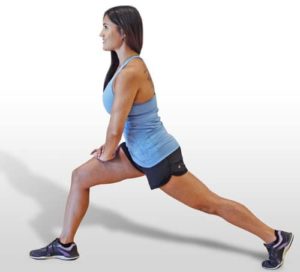Client Handouts/Tips for Clients
The Anatomy of Functional Training Risks
Many clients can’t seem to get enough of workouts that meld functional movements with high-intensity resistance training. Indeed, workouts using dynamic, high-intensity, full-body movements are great for strength and health—provided the body functions properly and exercisers use correct technique.
The Pelvic Floor: Base Support & More
Does the pelvic floor get the props it deserves? Many fitness professionals who specialize in women’s health think it warrants more respect and attention. Trista Zinn, founder of Hypopressives in Toronto, says the pelvic floor is “overlooked and misunderstood by many.” She adds, “Our quality of life and athletic performance literally rest on [the pelvic floor’s] synergistic ability to function with the core as a whole.”
Cultivate Joy Through Mindfulness
It’s a busy, technology-dominated world—and most of us are continually spinning, twisting and turning in an effort to “get things done” and “produce.” We work, we raise families, we have countless responsibilities. The truth is, this is distracted living, and it raises stress levels, lowers productivity and interferes with our ability to focus. When we live this way, we fail to cultivate a sense of contentment and joy.
Move 3 for Every 30
With most U.S. adults sitting 9–12 hours daily and the risks of inactivity becoming more apparent, the popular press and the scientific community concur that “sitting is the new smoking.” Indeed, there is mounting evidence linking sedentary lifestyles to cardiovascular diseases and all causes of mortality (Diaz et al. 2017).
Though the threat seems clear, one major question has puzzled researchers: Can people reduce their risks by taking short breaks in otherwise long periods of sitting still?
Your Epidermis Is Showing!
Some anatomy geeks get a kick out of asking unsuspecting people to name the largest system or external organ in the body. The answer: The integumentary system, of course, which includes the skin, hair, nails, and sebaceous and sweat glands (Springhouse 2002). Its main function is to protect the body from “the outside world” (bacteria, for example), but it also eliminates waste products, regulates body temperature and retains body fluids (AAAS 2017).
Sample Class: Tabata-Inspired Blast
The high-intensity interval training wave is still cresting, thanks to its positive metabolic effects and its ability to elicit results. HIIT raises the anaerobic threshold and creates excess postexercise oxygen consumption (EPOC), or oxygen debt. Simply put, metabolism stays elevated for longer after an intense workout than it does after low-intensity exercise.
“How do you handle the situation when clients want to discuss political matters with you?
Handling political discussions during a training session can be tricky. Clients come to sessions stressed-out already, and talking politics does not help reduce their stress level. Living near Washington, D.C., many of my clients are involved in politics or hold positions that are severely affected by the new administration’s direction.
Getting Better at Recovery
A growing body of research is shedding more light on the importance of resting after exercise—providing vital clues on measuring and enhancing the recovery process. These insights are welcome news to personal trainers and coaches who see the consequences of overtraining and inadequate recovery every day. This column discusses some of the latest research on assessing and managing recovery and advises on tactics that may help your clients recover from exercise.
A Weigh-In a Day Keeps the Pounds Away?
Stepping on the scale daily may help women lose weight, according to a
new study. For 2 years, at intervals, 294 college-age women provided information on their self-weighing practices and underwent body mass index and body fat testing. According to the data, women who weighed themselves daily saw significant decreases in BMI and body fat percentage over time.
Turn Negatives Into Positives
I was a new group fitness instructor taking someone else’s muscle-toning class. “You’re not going low enough,” the instructor yelled at me from across the crowded room. As flames of embarrassment burned my cheeks, I dropped lower into the Romanian dead lift even though I had just come from teaching my seventh cycling class of the week and my body was spent. But this was what the class required, I rationalized, and I was fit—I should be able to keep up.
Unfortunately, I couldn’t keep up, and as a result, I gave myself a nagging lower-back injury.
Recovery Tech—An Array of New Products, Services and Centers
New technologies, products and services are boosting the exercise-recovery business. What’s going on here?
The rising popularity of wearable devices is making people much more aware of their performance.
High-intensity interval training remains one of the most popular kinds of exercise.
Everyday exercisers can now afford treatments that were formerly reserved for pro athletes.
Hit the Hips!
Eager class participants want to tap into their highest potential, and group fitness instructors have been acknowledging this by offering workouts that are more explosive, more powerful and fuller in range than ever before. However, intense, dynamic workouts demand a warmup that truly prepares the body. Specifically, you must target the hips—hip flexors, piriformis, glutes and hip rotators—to avoid possible tweaks from all those lunges, squats and burpees (not to mention repetitive stress from cycling and running).
“How do you incorporate breathing strategies into clients’ workouts?”
Breathing strategies help keep clients focused on the movement and minimize distractions. When your clients take a deep breath just before a set, they can turn their thoughts inward and focus on proper body alignment, rather than moving the weight. This improves body awareness and posture and creates better engagement of the muscles needed for the lift.
The Functional Movement Screen and Active Older Clients
Study reviewed: Mitchell, U.H., et al. 2016. Performance on the Functional Movement Screen in older active adults. Journal of Sport and Health Science, 5 (1), 119–25.
Why Proper Rib-Cage Position Is Important
Proper thoracic-cage functioning sets the groundwork for healthy movement.
Conditioning for Kayaking
Did you know that 13 million people participated in some form of kayaking in 2014, making it one of the most popular flatwater sports (Outdoor Foundation 2015)? If you’re a kayaker, you know that the main challenges are building upper-body strength for paddling and maintaining a strong lower back to avoid back pain.
Music Listening, Meditation and Brain Fitness
Older adults may be able to enhance memory and brain fitness by meditating or listening to music, according to preliminary research findings reported in the Journal of Alzheimer’s Disease (2017; 56 [3], 899–916). West Virginia University researchers in Morgantown, West Virginia, conducted the study to determine whether simple mind-body practices could boost cognition or improve perceived memory loss among older adults with cognitive decline.
Health News: Fact or Fiction?
A flood of faulty health news information online has surged in the past few years, experts say. Fitness pros are hardly immune.
Mind-Body Exercise and Menopause
Are you in menopause? Chances are that you sometimes feel that you are not in control of your body! If you are seeking ways to cope with unpleasant menopausal symptoms, you may want to try yoga and other mind-body practices.
Shirley Archer, JD, MA, 2008 IDEA Fitness Instructor of the Year, an award-winning author and IDEA’s mind-body spokesperson, explains the research and application of mind-body exercise on menopause.
Irritability and Mood Swings
Get in the Game!
Fitness facilities compete to offer cutting-edge movement trends, but what about cutting-edge technology? The fitness world is becoming ever more virtual, and incoming clients are looking for more than a fun indoor cycling class or a cool cardio machine; they want to play a game!



















